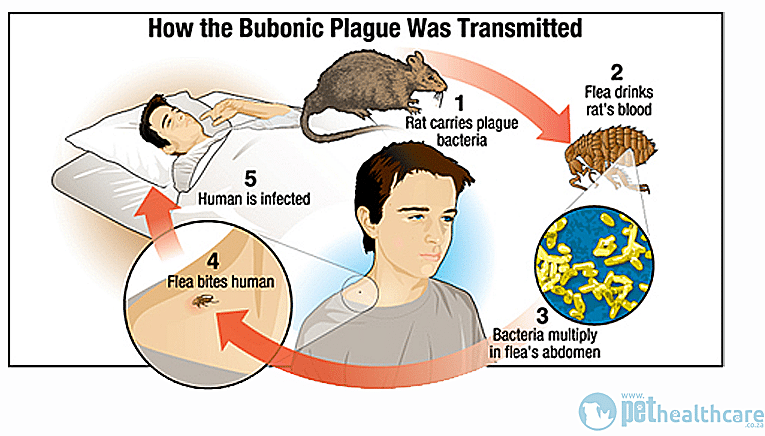
In Arizona found fleas infected with the Black Death, the disease that decimated 60% of the European population in the 14th century. Three human cases (recovered)
– Thu, 17/08/2017 – il Giornale.it
 There black Plague she was not defeated. Not entirely, at least. This is demonstrated by the new outbreak confirmed by the authorities in Arizona, where fleas infected with what was called the "Black Death" in the Middle Ages have been found in recent days.
There black Plague she was not defeated. Not entirely, at least. This is demonstrated by the new outbreak confirmed by the authorities in Arizona, where fleas infected with what was called the "Black Death" in the Middle Ages have been found in recent days.
A plague that killed, according to historians' estimates, about 60% of the European population with its epidemics that broke out in the 14th century. Only the arrival of antibiotics has allowed it to be eradicated in Europe and Australia, but it survives in some areas of South America, Africa and in some cases even in the USA.
The Navajo and Coconino Departments of Health (Arizona), in fact, in recent days they have confirmed that they have found the plague on some fleas in dogs in the city of Taylor. The invitation of the authorities, as reported by Corriere, was obviously that of prudence, trying to avoid contact with animals that could act as a vehicle for infected fleas: dogs, rodents, rabbits and their predators.
How the plague can it reach man? As long as an infected flea bites a human being or comes into contact with an infected animal, the Death Star can attack the human immune system. Simple and lethal, even if by now the mortality rate is  very low.
very low.
The latest cases of infection on humans date back to a few months ago, at the beginning of the summer, when three people were hospitalized in Santa Fe, New Mexico. These were a 63-year-old man and two women, aged 52 and 62. All are out of danger after spending a few days in hospital.
The numbers collected by Center for Disease Control (CDC) speak of about a thousand cases in the US between 1900 and 2012, while the World Health Organization estimates the total number of infections per year around the world at 3,000. The worst year for the US was 2006 when 2 people lost their lives to the Black Death.
Ed: In the image on the left the plague doctor, etching by Paulus Furst 1656 (from J. Columbina): during the epidemic of plague of 1656 in Rome doctors believed that this clothing protected from contagion and therefore wore a waxed cloak, a sort of protective goggles and gloves, while aromatic substances were found in the beak
The origin of the plague is very ancient (Thucydides mentions it in the 5th century BC), and due to its destructive force, it has become the 'black death' in the collective imagination, the disease that has accompanied humanity over the centuries and which for this reason it is often present in the great literary and artistic works. The story of the Great Plague in Europe in the 1350s, which claimed the lives of almost a third of Europe's population and literally infected every country from the Mediterranean to Scandinavia and Russia within five years, is particularly sinister because it was the consequence of a deliberate act of bioterrorism.
In 1347, in fact, the army of the Tartars was besieging Caffa (today's Feodosia), commercial port of the city of Genoa in the Crimea. The ranks of the Eastern army were upset by an epidemic of plague, which had spread in Asia for some years and so the khan Ganibek decided to use the infected bodies of the dead soldiers to conquer the city, catapulting them beyond the walls. Genoese sailors escaping from Caffa brought the plague to the Mediterranean ports and from there the disease spread throughout Europe. And in Europe it remained endemic, returning in cycles of 10-12 years, for at least the following three centuries. In recent scientific research, using new techniques, scientists Hendrik Poinar, Kirsti Bos and Johannes Krause have proved that it was a variant of Yersinia pestis, now extinct, to cause the first epidemic between 1347 and 1352
The doctors of the time were disoriented in the face of this phenomenon, incomprehensible to them. In case of plague, the doctor's only duty was to invite the sick person to confess. The remedy that doctors most frequently resorted to was fumigation with aromatic herbs such as eg. rosemary mint and lemon, which effectively repel fleas; unfortunately, however, applying these practices to an infected person was completely useless.
The pathogen of the plague is Yersinia pestis discovered in 1894 by Alexandre Yersin. It is a Gram-negative coccobacillus belonging to the non-coliform Enterobacteriaceae family.
To reduce the chances of death it is essential to treat with antibiotics within the first 24 hours of the onset of symptoms, with streptomycin, gentamicin, tetracyclines or chloramphenicol. Treatment with antibiotics is recommended, according to the American CDC, for seven days even in people who potentially come into contact with the patient
Related news: National Center for Disease Prevention and Health Promotion of the National Institute of Health. Plague: general information
Corriere della Sera. Plague outbreak in Arizona, infected fleas and three human cases (recovered)

But what I cannot enter belongs to these gentlemen doctors; confess that we find ourselves under such an evil conjunction, and then come and tell us, with cheek: don't touch here, don't touch there, and you'll be safe! As if this avoidance of material contact with earthly bodies could prevent the virtual effect of celestial bodies! And so much toil to burn rags! Poor people! will you burn Jupiter? will you burn Saturn?
His fretus, that is to say [ed: trusting] on these beautiful foundations, he took no precautions against the plague; clung to him; he went to bed, to die, like a Metastasio hero, blaming the stars.
(Don Ferrante - The Betrothed, chapter XXXVII - A. Manzoni)





